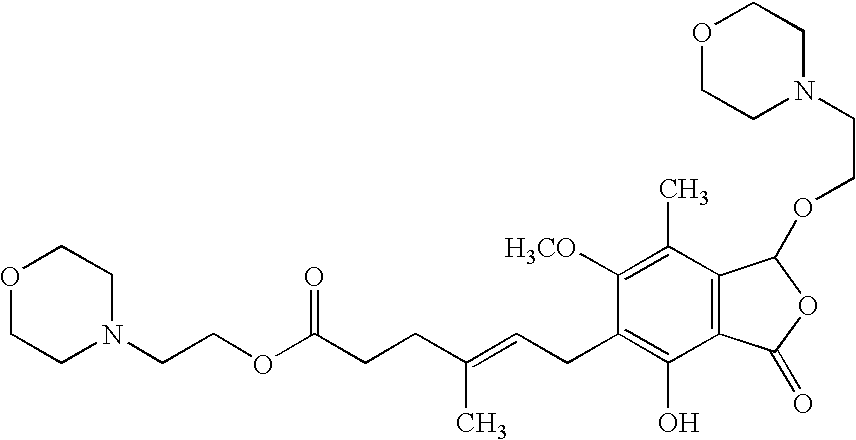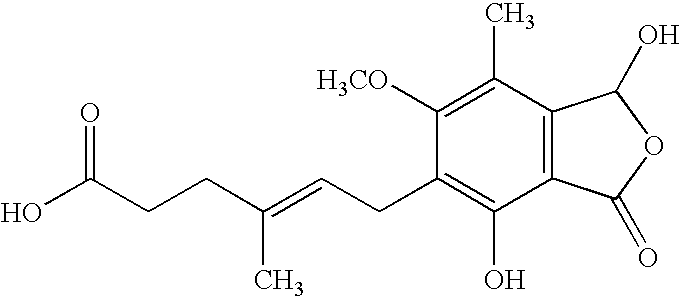Method for the purification of mycophenolate mofetil
a technology of mycophenolate and mofetil, which is applied in the field of purification of mycophenolate mofetil, can solve the problems of large loss of desired product mpm, cumbersome and expensive, and formation of unwanted impurities
- Summary
- Abstract
- Description
- Claims
- Application Information
AI Technical Summary
Benefits of technology
Problems solved by technology
Method used
Image
Examples
example 1
Conversion of MPA-Triethylamine Salt (MPA-TEA) Into MPM
[0042]MPA-TEA (15.0 g; 73.5% MPA; 1.1% MPA-OH; 34.5 mmol MPA) and 2-morpholino-ethanol (2.25 ml; 18.3 mmol) were suspended in xylene (60 ml). The mixture was heated to 120-125° C. A positive nitrogen flow was applied during the reaction. After 6 hours additional 2-morpholinoethanol (1.55 ml; 12.6 mmol) was added. After 22 hours another portion of 2-morpholinoethanol (0.7 ml; 5.7 mmol) was added (in total 4.5 ml 2-morpholinoethanol; 36.6 mmol). The reaction was followed by HPLC:
[0043]
ReactionMolar excessConversion toRatio Impuritytime (h)2-morpholinoethanolMPM (%)B / MPM (w / w %)30.524.50.1660.539.70.23220.974.90.60291.181.00.5846.51.187.10.65541.188.40.63711.190.30.64
[0044]After the analytical sample at 71 h, the reaction mixture was cooled to 12±3° C. and the mixture thus obtained contained 91.4% (w %) MPM and 0.58% (w %) Impurity B.
example 2
Purification of MPM by Extraction at Different pH Values
[0045]The reaction mixture obtained in Example 1 (60 ml) was diluted with water (60 ml). Under stirring the pH was adjusted to 2 with 6N H2SO4 at 12±3° C. The phases were separated. The aqueous phase was extracted three times with EtOAc (40 ml) at pH 2.2 at 12±3° C. in order to remove unconverted MPA. The aqueous phase was divided into six portions of 20 ml. To each portion EtOAc (40 ml) was added and the pH of the six mixtures was adjusted to 3.5, 3.75, 4.0, 4.25, 4.5 and 5.0, respectively using 4N NaOH at room temperature. The phases were separated, giving EtOAc phases 1 and water phases 1; these phases were analyzed by HPLC.
[0046]All EtOAc phases 1 were washed with 20 ml water at the same pH as the fore-going extraction (3.5, 3.75, 4.0, 4.25, 4.5 and 5.0, respectively) at room temperature. The phases were separated giving EtOAc phases 2 and water phases 2; also these phases were analyzed by HPLC.
[0047]The results are as foll...
example 3
Isolation of MPM
[0060]The reaction mixture obtained in Example 1 (60 ml) was diluted with water (60 ml). Under stirring the pH was adjusted to 2 with 6N H2SO4 (4.7 ml) at 12±3° C. The phases were separated and the aqueous phase was extracted three times with EtOAc (3×40 ml) at pH 2.1 at 12±3° C. EtOAc (160 ml) was added to the water phase and the pH was adjusted to 4.25 with 4N NaOH (8.3 ml). The phases were separated and were analyzed by HPLC (water phase 1 and EtOAc phase 1). The EtOAc phase was washed with 80 ml water at pH 4.5 (pH adjustment with 20 μl 6N H2SO4). The phases were separated giving water phase 2 and EtOAc phase 2. Both phases were analyzed by HPLC. Water (80 ml) was added to EtOAc phase 2 and the pH was adjusted to 8.15 with 4N NaOH (˜0.1 ml). The phases were separated and the EtOAc phase 3 was analyzed by HPLC as summarized in the Table below. Finally EtOAc phase 3 was washed with water at pH ˜6.
[0061]ZetaCarbon powder R55SP from Cuno (0.75 g) was added and the mi...
PUM
| Property | Measurement | Unit |
|---|---|---|
| pH | aaaaa | aaaaa |
| pH | aaaaa | aaaaa |
| pH | aaaaa | aaaaa |
Abstract
Description
Claims
Application Information
 Login to View More
Login to View More - R&D
- Intellectual Property
- Life Sciences
- Materials
- Tech Scout
- Unparalleled Data Quality
- Higher Quality Content
- 60% Fewer Hallucinations
Browse by: Latest US Patents, China's latest patents, Technical Efficacy Thesaurus, Application Domain, Technology Topic, Popular Technical Reports.
© 2025 PatSnap. All rights reserved.Legal|Privacy policy|Modern Slavery Act Transparency Statement|Sitemap|About US| Contact US: help@patsnap.com



